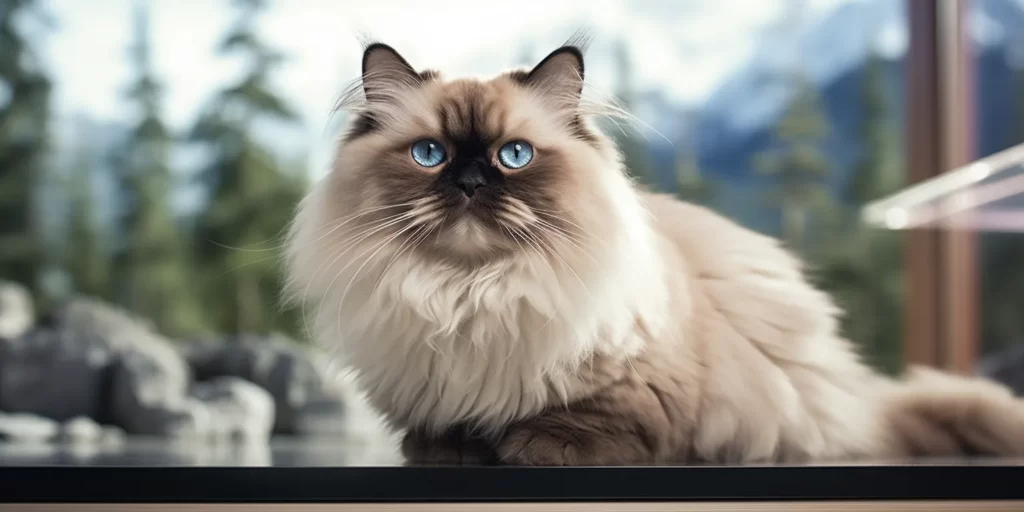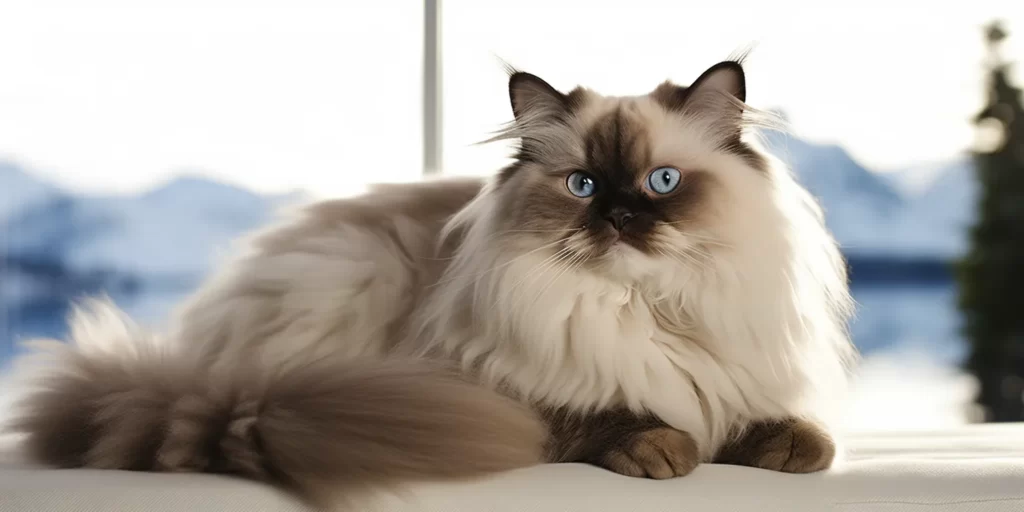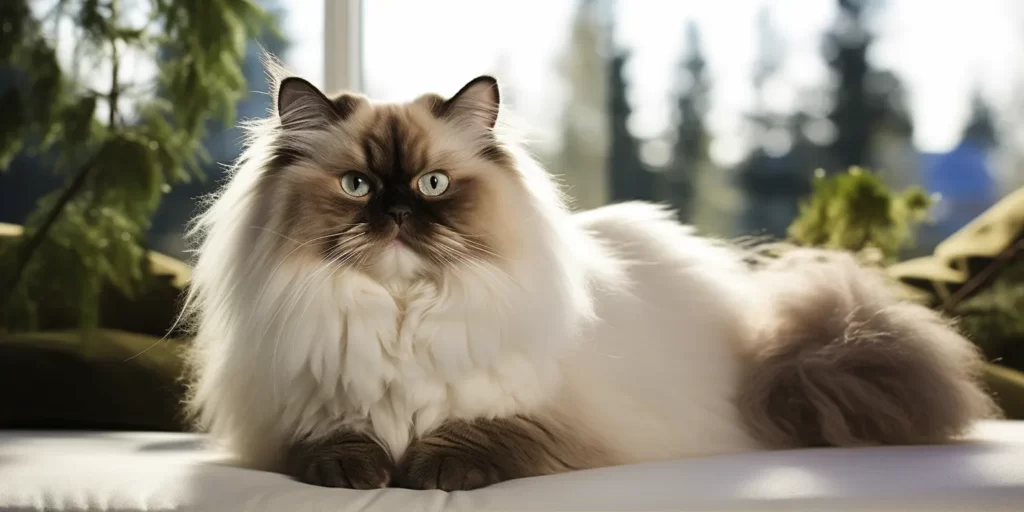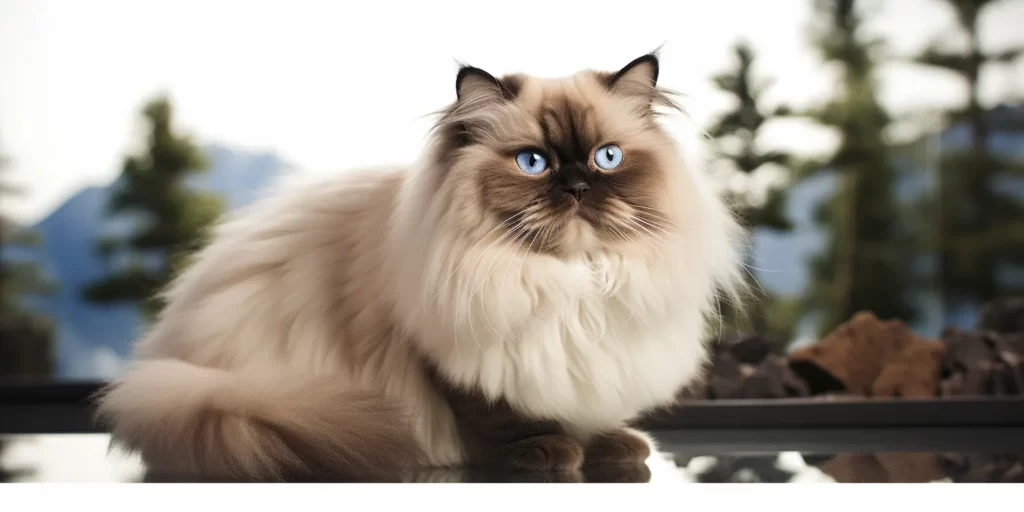The Himalayan cat is an ideal pet for anyone who loves both the beauty and personality of a Persian but also wants the playful nature of a Siamese. These cats make wonderful companions, as they are highly affectionate and love to be around their human family.
They tend to form strong bonds with their owners, often following them around or seeking out cuddles and lap time. They also have high intelligence levels, so they can easily learn new tricks or commands if trained properly.
With the right care, diet, health, and grooming knowledge, you can be a purrfect parent to your Himalayan cat and ensure they live a long and happy life. So let’s begin!
Breed Overview

The Himalayan, or Himmie for short, is a special breed of cat that has been crafted through years of selective breeding. Combining the best traits of the Persian and Siamese, the Himalayan is considered one of the most beautiful cats in the world.
The Himalayan’s story began in 1931 when breeder Virginia Cobb and Harvard researcher Clyde Keeler set out to discover this breed. The goal was to understand how the colorpoint gene was passed on from one generation to another.
Through their efforts, they created a Persian cat with distinctive colors similar to those seen on Siamese cats. The first such kitten was named Newton’s Debutante and it marked the beginning of this new breed that would come to be known as the Himalayan.
In the beginning, some cat associations considered this breed as a color morph of the Persian cats. But we and some other cat associations like TICA believe that this is a different breed as they have completely different personalities and colors.
Overall, whether it’s called an exotic breed or simply part of Persia’s beautiful family tree; there is no doubt that Himalayans are truly unique creatures worthy of admiration!
With their captivating looks and sweet temperament, these gorgeous felines continue to captivate our hearts.
Related: Asian Cat Breeds with Captivating Histories and Origins
Identifying Himalayan Cat
The Himalayan is an enchanting cat, with its luxurious coat and captivating eyes. Its large, round head is set on a short neck, giving it a strong presence.
The ears are small and rounded at the tip and set low on the head which gives it an endearing look.
The body of this medium-to-large cat is equally massive across the shoulders and rump with heavy boning giving it an overall appearance of soft roundness.
What makes the Himalayan unique is its coat pattern which consists of two colors with patterns of Siamese cats. The ears, paws, tail, and face have darker patches that make this cat look very different from Persian cats.

This cat has thick and long fur with a flat face similar to Persian cats. This long-flowing coat requires constant grooming due to its undercoat which can easily mat if not taken care of.
Himalayan cats are quite a sight to behold. With their light-colored bodies and darker points, they look like little snow leopards! But that’s not all: these cats also have beautiful blue eyes that make them stand out from the crowd.
The colors of Himalayan cats can range from red to cream, seal to blue, chocolate to lilac, and tortoiseshell to blue cream. Not only do they come in a variety of colors but their true beauty comes from their pointed patterns. This makes this cat a very desired breed that many love to own.
Personality Traits
The Himalayan is a gentle, loving breed that thrives on human companionship. Its sweet and quiet personality makes it an ideal pet for those looking for a calm and loyal companion.
Unlike some of the more active breeds, the Himalayan prefers to cuddle up with you rather than run around your house getting into mischief. They are also sensitive to their owner’s moods and emotions, which can make them an even better furry friend.
Himalayans show their appreciation for attention in the form of quiet meows and adoring looks from their big blue eyes. But they don’t require constant attention like some breeds.
From expensive toys to just a balled-up piece of paper, this breed loves playing with almost anything they can get their paws on!
These cats are gentle and loving creatures who do not mind the occasional pat or cuddle from a child. However, Himalayans need to be handled with care as they can easily become stressed in a chaotic environment.
These cats also get along well with other animals such as dogs, provided that the dog is friendly and does not chase them around.
Generally speaking, these cats prefer quieter environments rather than households full of children running around and making noise. As long as their home remains relatively calm and peaceful, the Himalayans will live happily in any household.
Activity Level
Himalayan cats are not particularly active, but they do enjoy short bursts of activity. They will spend much of their time lounging in the sun or sleeping on your bed. But every so often they will suddenly become curious and want to explore their environment.
Although these cats require far less exercise than other feline breeds, it is still important to maintain an active lifestyle for them. Interactive toys such as catnip mice or balls can help stimulate them to stay fit and healthy while also providing hours of entertainment.
Himalayans tend to be very friendly and accepting of changes in routine but it’s ideal to set a daily playtime. Daily activities keep them stimulated mentally and physically which results in a healthier cat.

Himalayan Cat Loyalty
Himalayan cats are renowned for their loyalty. Not only do they form strong bonds with their owners, but they also have the potential to be intensely loyal to one particular person. This makes them ideal pets in many households, as they can provide companionship and comfort to anyone who needs it.
These cats love to show affection and will often follow their chosen human from room to room. They are highly intelligent animals that enjoy interacting with humans on a deeper level than most other breeds of cats.
Himalayans mostly express their loyalty through purring, cuddling up next to you, or even bringing gifts such as small toys or dead mice!
Love Of Water
Himalayan cats have thick fur that requires regular baths to stay clean. However, many owners may be surprised to find out that these cats enjoy the water!
Despite their long coats, they can swim and are known for playing in shallow pools or puddles. Even if your Himalayan doesn’t take a dip in the pool or lake, they will likely still love getting wet during her baths.
Bathing a Himalayan from a young age will help them become accustomed to it and even come to look forward to it. We will discuss this further in the care section of this article.
Trainability
Himalayan cats are known for their intelligence, making them an ideal candidate for training. With patience and consistency, it’s possible to train your Himalayan to do certain behaviors such as walking on a leash or coming when called.
Short training sessions work best due to the cat’s short attention span, but even these brief intervals can help reinforce desired behaviors.
Keep in mind that Himalayan cats are also known for being independent and aloof. This means that they may show less interest in training at times so don’t force it!
If you’re hoping to teach your Himalayan more complex behaviors like tricks or agility courses, you may need extra patience and creativity.
Adult Size
Himalayan cats, despite their large and fluffy fur coats, are medium-sized cats. They are a bit larger than other cats in the Persian Breed Group due to their thick fur.
The average height of an adult male Himalayan cat is between 8 and 10 inches, while females tend to be slightly smaller. They usually weigh between 6 and 12 pounds, depending on age and gender.
In terms of length, most Himalayan cats measure about 2 feet from head to tail tip when fully grown. With their thick fur, these felines look so much bigger than they are. All that fluffy fur makes them appear even larger than they already are!
As kittens, their growth rate can vary from 5 to 10 months before reaching the full size of an adult Himalayan Cat. During this period, they tend to grow rapidly in length and width but not necessarily in height as compared to other breeds.
As young adults, the growth slows down considerably and eventually stops when they fully mature at about 3 – 5 years old. After that point, they may gain weight slightly due to increased muscle mass or fat storage but won’t experience any drastic changes in size or shape throughout adulthood.

Life Expectancy
The Himalayan cat is a beloved breed renowned for its beautiful coat and friendly personality. With proper care, they can be expected to live between 8 – 11 years, making them an excellent choice for those looking for a long-term companion.
To ensure that your Himalayan reaches its maximum life expectancy, you need to focus on food and exercise.
Providing your cat with plenty of exercise and playtime is essential in promoting good health and longevity. Taking them on regular walks or playing interactive games with them will help keep their mind sharp and their body fit.
It’s also important to give them healthy food that meets all of their nutritional needs. This can include different high-quality foods that we discuss further in the diet section of this care guide.
Himalayan Cat Care
Caring for a Himalayan Cat is an important responsibility. This beautiful breed of cat has long, luxurious fur that requires daily grooming, regular bathing, and a clean litter box to keep them looking their best.
Daily grooming should be done gently but thoroughly with a comb or brush. This will help to prevent tangles and mats in the coat, as well as keep it looking clean and healthy.
Regular bathing at least once per month is also recommended. This is to ensure their coat stays soft and shiny. It can also reduce shedding which is especially beneficial if you have allergies in the home.
The litter box needs to be clean at all times so that there are no clumps of litter sticking to your Himalayan’s paws or coat. If this issue isn’t addressed promptly, your beloved pet may stop using the box altogether!
Additionally, the excess tearing can lead to eye stains around their face so make sure you wipe down the corners of their eyes. You can check the eyes daily and clean them with a soft damp cloth or tissue paper specifically made for cats. This will help prevent any staining from occurring in the first place!
Finally, brushing your cat’s teeth regularly (at least once weekly) is essential for preventing disease. Dental diseases can cause pain and discomfort for your pet and often make you take them to the vet. So try to brush their teeth to prevent unwanted circumstances.
Overall caring properly for a Himalayan Cat requires dedication but pays off with having an incredibly beautiful animal companion in return! With regular care, your cuddly kitty will stay happy & healthy throughout its life!
Diet
The Himalayan Cat is a member of the Persian Group, so their nutrition requirements are similar to any other cat in the group. A high-quality diet that contains proper protein and nutrients is recommended for these cats.
Owners should be mindful of both the quality and quantity of food they feed their cats to keep them at a healthy weight. Supplementation may also be necessary depending on your cat’s individual needs or age.
However, always speak to your vet first before adding any vitamins or supplements to their diet. This is because some may interfere with existing medications or cause unwanted side effects such as digestive upset.
Himalayan cats tend to become overweight after being spayed or neutered, so you must monitor their diet and adjust portions accordingly if necessary. Regular exercise can also help maintain an appropriate body condition score.
Himalayan cats also require fresh drinking water available at all times. This is to ensure your cat is properly hydrated throughout the day. Additionally, your cat might prefer a water fountain to drink from. So keeping a few different water sources is recommended.
Keep in mind that the water bowl(s) should be cleaned regularly. This is due to the fact that dirty water can make your cat sick easily.
You should also monitor how much water your cat drinks each day to ensure optimal health. If you feel your cat isn’t drinking enough then try moving the location of their bowl or offering them wet food.
Wet foods contain more moisture than dry kibble and help your cat to get more water throughout the day. Being aware of changes in behavior and keeping an eye on your pet’s health is key for a healthy cat.

Exercise Requirement
Keeping the Himalayan cat active helps not only keep her in optimal condition but also wards off potential health issues. Exercise strengthens the muscles and joints, helping to prevent joint pain or arthritis.
Playing stimulates both mental and physical activity; keeping the mind sharp as well as preventing a sedentary lifestyle. It’s also an ideal way for them to burn off excess energy that could be channeled into destructive behaviors.
Encouraging playtime with interactive toys like balls, feather wands, stuffed animals, catnip mice, and other items. This will help provide your Himalayan with the stimulation they need while giving them an outlet for their natural hunting instinct!
Playing can also help form a strong bond between you and your cat. Cats can remember the people that are nice and interact with them.
Shedding Levels
Himalayan cats are known for their long, luxurious coats and often shed more than other breeds. During the shedding season, which is typically in the spring and fall, the Himalayans can shed even more heavily.
During these times of heavy shedding, it’s important to brush them daily or even multiple times per day. This will help with removing loose hair and keep tangles away. This will also help minimize excess fur around your home.
At different stages of life, a Himalayan cat might go through periods of increased or decreased shedding due to changes in hormones or diet. As kittens, they may not shed as much since their coats are shorter but as they get older their sheathing will increase.
In older cats, there may be an increase in shedding if hormonal levels drop or their diet isn’t balanced properly so make sure they’re always eating well!

Health Issues
Himalayan cats are generally healthy, but like all cats, they can be susceptible to certain health issues. The most common diseases for this breed include Polycystic Kidney Disease (PKD), respiratory problems, and eye problems such as Progressive Retinal Atrophy (PRA) and Hypertrophic Cardiomyopathy.
Owners of these cats should take extra caution and make sure their cat is regularly checked by the vet. This will ensure any potential illnesses are caught and treated quickly.
Poor diet and living conditions can negatively impact a cat’s health in many ways. A poor diet, lacking in essential vitamins and minerals, can lead to many health problems. These include weight loss, coat problems, skin ailments, a weak immune system, and other serious health issues.
Poor living conditions such as overcrowding or unsanitary environments can also cause various infections and diseases.
To prevent diseases and keep your cat healthy it is crucial to provide them with a balanced diet of high-quality food and care. Also, keep their environment stress-free and ensure that they are receiving proper vaccinations.
Buying Tips
- Research: Before purchasing a Himalayan Cat, research the breed and make sure it’s right for you. Learn about their temperament and life expectancy, as well as any health issues they might be prone to.
- Reputable Breeder: When looking to buy a Himalayan Cat, find a reputable breeder who is knowledgeable about the breed and can provide you with information on its lineage and health history. Ask other owners for referrals or check with your local animal shelter or rescue organization to see if they have kittens available from reputable sources.
- Visit the Kitten: Once you’ve found a breeder that meets your needs, spend some time getting to know the kitten before deciding whether he/she is right for you- make sure he/she has an outgoing personality that matches yours! The more socialized the kitten is when it comes home with you, the better off it will be in its new environment!
- Health Checkup: Before bringing your kitten home, have them checked out by a vet so they can assess his/her general health condition and recommend any necessary vaccines or treatments before coming home with you.
- Diet & Nutrition: Make sure to ask about the food the breeder has given them and ask about all supplements and foods your cat needs. Knowing this information is crucial in the first few weeks of bringing them home.
Related: 250+ Amazing Himalayan Cat Names & How To Select One!

Conclusion
If you are looking for a loyal, intelligent, and beautiful pet, the Himalayan Cat is an excellent choice. Not only do they have stunning good looks that will turn heads wherever they go, but their calm and gentle personality makes them perfect companions.
They are also incredibly smart cats who thrive on human interaction and can learn tricks quickly with proper training. With all these qualities combined, it’s no wonder why the Himalayan Cat is one of the most beloved breeds in the world today.